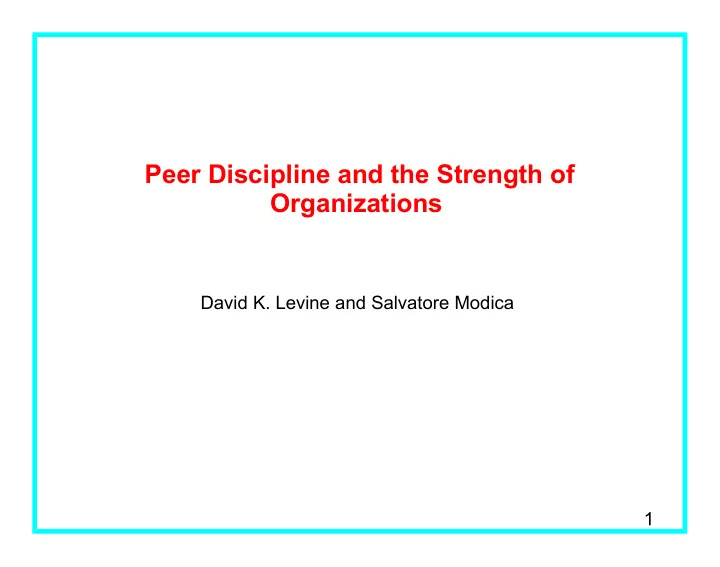

Peer Discipline and the Strength of Organizations David K. Levine and Salvatore Modica 1
Introduction • Groups do not act as individuals • Olson and others have emphasized incentives within groups matter • Not so much formal research on the subject, especially on the internal working of group discipline • Group strength depends on including size and cohesion of the group. • We study self-sustaining discipline through a model of costly peer auditing and punishment in a collusive group • This punishments should be self-enforcing, so there must be an infinite sequence of audit rounds • Initial choice of action by group members in a base game followed by an open-ended game of peer punishment 2/11
The Discipline Model identical players in group initial round - round zero, players choose primitive actions action of representative member, player gets payoffs this initial primitive round is followed by an infinite sequence of possible audit rounds where players are assigned to audit other players auditors receive signals of the auditee's behavior in the previous round only based on the signal auditors may assign additively separable punishments there is no discounting, but the game may be (randomly) ended in effect the discount factor is a design parameter it is not desirable to let the audits continue with too high a probability, since the punishments cumulate (Hatfields and McCoys) 3/11
Signals behavior in the primitive round generates a binary good/bad signal with probability of a bad signal equal to (non-binary signals also considered) obviously the signal should provide some information about whether a player deviated if it is to be useful – this is called enforceability and the paper gives the relevant criteria 4/11
Audit Rounds players matched in pairs as auditor and auditee matches may be active or inactive if match inactive • current auditee an auditor in inactive match in previous round, current match inactive • remaining matches are active round in an active match auditor assigned to audit observes signal of the behavior of the auditee and has two choices recommend punishment ( ) or not to recommend punishment ( ), based on a member 's behavior as auditor in an active match at signal generated punish on bad signal or not on good signal, bad signal with probability else with probability 5/11
Costs and Punishments Payoffs additively separable between initial primitive utilities and costs incurred or imposed during auditing No discounting Following a recommendation of punishment a punishment is imposed. Auditor suffers a utility loss of auditee suffers a utility loss of other members of the group share a utility loss of 6/11
Implementations procedure for matching and a profile of punishment costs note that “all matches inactive” means that de facto the audit rounds are over matching is “exogenous” may depend randomly on history of previous matchings and punishment profiles but not on private signals or punishment recommendations auditor does not need to worry that his future matchings will depend on what he does 7/11
Peer Discipline Equilibrium pure strategy perfect public Nash equilibrium in which all players follow the strategy of punishing on the bad signal and not punishing on the good signal we are interested in collusive groups, so are interested in the peer discipline equilibrium that supports a particular first period primitive action and minimizes enforcement costs 8/11
Two-Stage Implementation beginning of the first audit round - or equivalently at the end of the initial primitive round - the probability of the game continuing to the first audit round beginning of the second audit round and in all subsequent rounds the continuation probability is matchings are symmetric punishments are fixed constants so that there is no net benefit to the group from carrying out a punishment 9/11
Optimal Punishment Plans Theorem: Utility of a representative group member is maximized given the non static-Nash enforceable initial action when the incentive constraints hold with equality. Specifically letting denote the maximum gain to deviating from this occurs when . If the equilibrium utility level is This theorem is robust to matching and ending procedures and punishment profiles that are linearly scalable 10/11
Application: Group Size and the Strength of Groups • group members provide indivisible effort to purchase a political favor • willingness to pay: single-peaked in group size • competition between groups in an auction • agenda setting 11/11
Recommend
More recommend